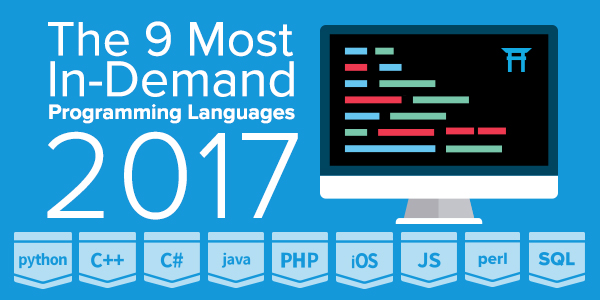
What are the most in-demand programming languages of 2017? Coding Dojo thinks it has the answer. Crunching data from Indeed.com, the coding bootcamp came up with
a list of nine it claims are drawing the most attention from employers. At the top of the list was SQL (Structured Query Language), which is used to manipulate databases (and features a number of popular variations, including MySQL). Coming in second was Java, followed by Python, JavaScript, and C++. On the back half of the list, C# came in sixth, followed by Perl, the iOS family (i.e., the Swift and Objective-C programming languages), and PHP. In its note accompanying the rankings, Coding Dojo also felt the need to call out Ruby on Rails, which dropped from ninth place on its 2016 list to seventeenth on the current one: “This may be caused by Ruby losing some of its market share to increasingly popular alternatives like Node.js and Go.” Or if you want it in Coding Dojo's nifty graphic form:

Coding Dojo’s note suggested that the languages in its rankings can rise and fall rapidly: “No programming language can accomplish every task and the job market changes quickly from year to year.” However, with regard to those top five languages, Coding Dojo’s 2017 list echoes the one it produced in 2016, when the top languages were SQL, Java, JavaScript, C#, and C++. Given the ubiquity of those languages within the tech industry, their hold on the top positions is unsurprising; for JavaScript to suddenly drop off, for example, thousands of developers and hundreds of companies would simultaneously need to stop using it. Other lists feature the same languages in the top slots. For example,
the TIOBE Index’s January edition put Java in first place among programming languages, trailed by C, C++, and C#, with Python rounding out the top five. Unlike Coding Dojo, which uses data from Indeed.com, TIOBE calculates its rankings based off data from 25 search engines, including Google and Bing (a lengthy breakdown of its methodology
is available on its site); the final list is meant as a gauge of popularity, not actual usage. For tech pros, the perseverance of the same programming languages at the top of these kinds of lists, year after year, is a good sign. It means that you can invest the time and effort necessary to learn those languages without worrying that demand will slacken in the near-term.
 What are the most in-demand programming languages of 2017? Coding Dojo thinks it has the answer. Crunching data from Indeed.com, the coding bootcamp came up with a list of nine it claims are drawing the most attention from employers. At the top of the list was SQL (Structured Query Language), which is used to manipulate databases (and features a number of popular variations, including MySQL). Coming in second was Java, followed by Python, JavaScript, and C++. On the back half of the list, C# came in sixth, followed by Perl, the iOS family (i.e., the Swift and Objective-C programming languages), and PHP. In its note accompanying the rankings, Coding Dojo also felt the need to call out Ruby on Rails, which dropped from ninth place on its 2016 list to seventeenth on the current one: “This may be caused by Ruby losing some of its market share to increasingly popular alternatives like Node.js and Go.” Or if you want it in Coding Dojo's nifty graphic form:
What are the most in-demand programming languages of 2017? Coding Dojo thinks it has the answer. Crunching data from Indeed.com, the coding bootcamp came up with a list of nine it claims are drawing the most attention from employers. At the top of the list was SQL (Structured Query Language), which is used to manipulate databases (and features a number of popular variations, including MySQL). Coming in second was Java, followed by Python, JavaScript, and C++. On the back half of the list, C# came in sixth, followed by Perl, the iOS family (i.e., the Swift and Objective-C programming languages), and PHP. In its note accompanying the rankings, Coding Dojo also felt the need to call out Ruby on Rails, which dropped from ninth place on its 2016 list to seventeenth on the current one: “This may be caused by Ruby losing some of its market share to increasingly popular alternatives like Node.js and Go.” Or if you want it in Coding Dojo's nifty graphic form:  Coding Dojo’s note suggested that the languages in its rankings can rise and fall rapidly: “No programming language can accomplish every task and the job market changes quickly from year to year.” However, with regard to those top five languages, Coding Dojo’s 2017 list echoes the one it produced in 2016, when the top languages were SQL, Java, JavaScript, C#, and C++. Given the ubiquity of those languages within the tech industry, their hold on the top positions is unsurprising; for JavaScript to suddenly drop off, for example, thousands of developers and hundreds of companies would simultaneously need to stop using it. Other lists feature the same languages in the top slots. For example, the TIOBE Index’s January edition put Java in first place among programming languages, trailed by C, C++, and C#, with Python rounding out the top five. Unlike Coding Dojo, which uses data from Indeed.com, TIOBE calculates its rankings based off data from 25 search engines, including Google and Bing (a lengthy breakdown of its methodology is available on its site); the final list is meant as a gauge of popularity, not actual usage. For tech pros, the perseverance of the same programming languages at the top of these kinds of lists, year after year, is a good sign. It means that you can invest the time and effort necessary to learn those languages without worrying that demand will slacken in the near-term.
Coding Dojo’s note suggested that the languages in its rankings can rise and fall rapidly: “No programming language can accomplish every task and the job market changes quickly from year to year.” However, with regard to those top five languages, Coding Dojo’s 2017 list echoes the one it produced in 2016, when the top languages were SQL, Java, JavaScript, C#, and C++. Given the ubiquity of those languages within the tech industry, their hold on the top positions is unsurprising; for JavaScript to suddenly drop off, for example, thousands of developers and hundreds of companies would simultaneously need to stop using it. Other lists feature the same languages in the top slots. For example, the TIOBE Index’s January edition put Java in first place among programming languages, trailed by C, C++, and C#, with Python rounding out the top five. Unlike Coding Dojo, which uses data from Indeed.com, TIOBE calculates its rankings based off data from 25 search engines, including Google and Bing (a lengthy breakdown of its methodology is available on its site); the final list is meant as a gauge of popularity, not actual usage. For tech pros, the perseverance of the same programming languages at the top of these kinds of lists, year after year, is a good sign. It means that you can invest the time and effort necessary to learn those languages without worrying that demand will slacken in the near-term. 


